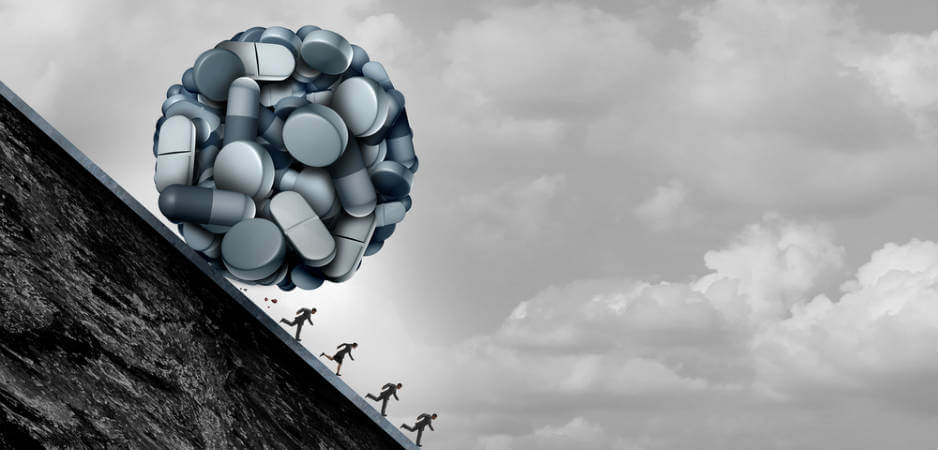Both the medical community and the US government fall behind on making the treatment of opioid addiction more effective.
Percy Menzies is a pharmacist by training and has worked for almost 18 years for a pharmaceutical company that developed and marketed a range of pain medications like oxycodone and oxymorphone. Even at that time, some 40 years ago, they knew these drugs were not appropriate for long-term use. “They were only for acute pain in hospitalized patients,” says Menzies.
Since then, an epidemic has ensued in the US, with over 33,000 people overdosing on opioids annually. Only recently has an antidote for an opiate overdose become prominent. The same company Menzies worked for, Dupont Pharmaceuticals, developed the antidote, naloxone (or Narcan), over 30 years ago. The antidote reverses the effects of opioids, knocking out opiates from receptors in the brain, which may slow or stop breathing. It is a temporary fix, buying time to get the person to a hospital.
“My job was to train physicians in how to use it,” said Menzies. “So Narcan is not a new drug. It’s an old drug that has suddenly come into prominence because of what is happening with the overdoses.” The company also developed a non-opiate medication to prevent people from relapsing, but even now the drug is hardly used. It is called Naltrexone and was developed during Richard Nixon’s time in office.
Nothing New
Menzies decries the failure to offer comprehensive treatment for opiate addiction. Even today, the three drug options available to treat addiction and prevent relapse — methadone, buprenorphine, better known as Suboxone, and Naltrexone — are operating under silos, according to Menzies. They are largely inaccessible to the public, and sometimes even to physicians.
In order to access methadone, for instance, that is used to treat addiction to opiates and other narcotic drugs, patients need to visit a methadone clinic every morning and stand in line for the daily dose. There are only 1,400 such brick-and-mortar clinics in the country. “After a period, if you do well, after six months to a year, and you’re keeping all your appointments, and they drug test you, and your urine is clean, free of any opioids, they might initially give you a weekend dose to take home. Then they might give you a week’s medication to take home as a privilege. But you can never get it in a physician’s office. You can only get it at the methadone clinic,” said Menzies.
Unlike any other drug under the sun, including opioids, in order to get Suboxone, which is an opioid medication like methadone, doctors must be licensed to prescribe it, and there are a limited number of doctors who have had the opportunity or have taken the time to sit the eight-hour certification test. “There are about 900,000 physicians in this country, and only about 25,000 have taken the DEA [Drug Enforcement Agency] exemption to write for Suboxone,” said Menzies. “And studies have shown that the average number of patients that these physicians have is around 14.”
Some physicians have not even heard of Naltrexone, an effective non-opioid option. “Why can’t methadone clinics be using all the medication? Why don’t they use methadone, Suboxone and Naltrexone?” asks Menzies. “We have to individualize the treatment. You cannot just tell patients the only drug to use is methadone, Suboxone or Naltrexone. All three should be used for the appropriate patient.”
The second problem is that treatment of addiction is almost completely out of the realm of medicine. Rehabilitation centers often do not coordinate with doctors’ offices and do not offer standardized treatment. “You know exactly what to expect for stroke rehab, what to expect for cardiac rehab. Nobody knows what addiction rehab is,” said Menzies.
What’s more, people with the means to travel to high-end rehabs distance themselves from their usual environment. Upon return, they can quickly relapse. “Some people go to these fancy programs in California, and they spend $30,000, $40,000 or $50,000. They get all sorts of therapies,” Menzies explains. “What they don’t realize is that when you take the patient away from the natural environment where they work and live, your addiction goes in an incubator. The addiction doesn’t go away. You are in a bubble. You are in a very isolated area. So you are distracted. You talk to other people, you eat some great food, you are in a very comfortable environment. But your addiction is getting stronger and stronger, and so as soon as you come back home, your cravings explode like a volcano.”
Because of this “deprivation effect,” Menzies thinks it is important that rehab follows patients home. As it stands, an addict could be treated for an overdose at the hospital and, within the hour, discharged without any sort of follow up.
“Imagine this being done with somebody with chest pains that you use a defibrillator to revive them, and then instead of keeping them in the hospital sending them home within the next hour. All hell will break loose, but here we do it all the time.”
Root Causes
Palliative care does not address the root causes of addiction, according to Menzies, who stresses the importance of cutting off the supply of illegal opiates, namely heroin, which is so readily available in the US. While Afghanistan and Myanmar supply most of the heroin worldwide, in the US it now comes mostly over the Mexican border. “You may have the tallest wall, the most beautiful wall, whatever you call it, you cannot stop it because it is so easy to smuggle things in,” said Menzies of heroin, a kilogram of which is easily taken through checkpoints, compared to, say, a bale of marijuana.
Now that marijuana is grown and readily available in 29 US states for both medical and recreational purposes, Mexican farmers are desperate for a livelihood and have turned to producing harder drugs, like heroin. “Young children are taken out of school who are 10 or 12 years old to harvest the opium poppy,” explains Menzies. “They have to make a slit in the opium poppy for the juice to be to ooze out. These children are ideal because they are the same height as the opium plant. It’s really sad what has happened.”
The US drives the supply of heroin in Mexico, where a war on drugs created the second deadliest conflict zone after Syria, and killed 23,000 people in 2016. Without pressure from the US to curb the cultivation of poppy in Mexico and to close down labs that process opium into heroin, this impoverished and unstable country will continue to be terrorized by drug cartels, which compete for territory within its own borders. The cartels take in between $19 and $29 billion annually from US drug sales.
“We have to offer aid to these impoverished regions to grow alternative crops and develop industries. Unlike marijuana and cocaine, opium poppy does not require as much acreage,” added Menzies. “The advances in drone technology can be used effectively to monitor the targeted area. Indeed, some trade and bilateral agreements could be tied to how effectively Mexico acts to curb this problem.”
The issue is so politically contentious that a collective strategy is non-existent, and curbing the demand for these drugs in the US is also a cause in need of funding. “I mean, I tell people that there are 23 million people [in the US] who are addicted to drugs and alcohol, and the last budget that Obama got approved he had allocated $5 billion for treatment of addiction to heroin and alcohol,” says Menzies. Compare that to 1.9 million people that are affected by HIV and AIDS in America, a cause that was allocated $27.5 billion in the same budget.
“Look at the phenomenal progress we have made in treating AIDS and HIV,” says Menzies. “Today, if you are HIV positive you can lead a very normal life. Your life expectancy is almost as much as people with no HIV, because we have gotten in the last 35 years almost 40 drugs developed to treat AIDS and HIV, and what do we have, three drugs for opiates.”
Menzies thinks that the key to changing our response to the crisis is to humanize it. “We have demonized it, we have moralized it, we have criminalized it, but we have not humanized like we did for AIDS and HIV,” she says. “Initially we were very moralistic with the AIDS epidemic occurred. We saw it as hedonism, as bad behavior and things of that sort, and all that changed once you put a human face to the problem.”
No one plans to be an addict. It is a culture that has been encouraged by pharmaceuticals, which poured billions into marketing opiates to treat any and all chronic pain. There has been little response from the medical community to make treatment more effective, and a dearth of funding to treat opioid addiction from the government.
The views expressed in this article are the author’s own and do not necessarily reflect Fair Observer’s editorial policy.
Photo Credit: / Shutterstock.com
Support Fair Observer
We rely on your support for our independence, diversity and quality.
For more than 10 years, Fair Observer has been free, fair and independent. No billionaire owns us, no advertisers control us. We are a reader-supported nonprofit. Unlike many other publications, we keep our content free for readers regardless of where they live or whether they can afford to pay. We have no paywalls and no ads.
In the post-truth era of fake news, echo chambers and filter bubbles, we publish a plurality of perspectives from around the world. Anyone can publish with us, but everyone goes through a rigorous editorial process. So, you get fact-checked, well-reasoned content instead of noise.
We publish 2,500+ voices from 90+ countries. We also conduct education and training programs
on subjects ranging from digital media and journalism to writing and critical thinking. This
doesn’t come cheap. Servers, editors, trainers and web developers cost
money.
Please consider supporting us on a regular basis as a recurring donor or a
sustaining member.
Will you support FO’s journalism?
We rely on your support for our independence, diversity and quality.







